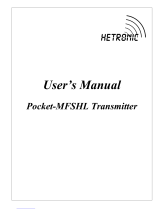
Table of contents
CX8030 / CX8031 3Version: 1.6
Table of contents
1 Notes on the documentation ....................................................................................................................5
1.1 Explanation of symbols................................................................................................................... 6
1.2 Documentation issue status............................................................................................................ 7
2 For your safety...........................................................................................................................................8
2.1 Intended use ................................................................................................................................... 8
2.2 Staff qualification ............................................................................................................................ 9
2.3 Safety instructions .......................................................................................................................... 9
3 Transport and storage ............................................................................................................................11
4 Product overview.....................................................................................................................................12
4.1 CX80xx - System overview........................................................................................................... 12
4.2 CX8030, CX8031 - Introduction.................................................................................................... 14
4.3 Technical data .............................................................................................................................. 16
4.4 Technical data - PROFIBUS......................................................................................................... 17
4.5 CX80xx - MicroSD cards .............................................................................................................. 19
5 Mounting and wiring ...............................................................................................................................20
5.1 Mounting ....................................................................................................................................... 20
5.1.1 Dimensions ......................................................................................................................20
5.1.2 Installation on mounting rails ...........................................................................................20
5.2 Wiring............................................................................................................................................ 23
5.2.1 Power supply....................................................................................................................23
5.2.2 Ethernet............................................................................................................................25
5.2.3 PROFIBUS.......................................................................................................................27
5.3 Changing the battery .................................................................................................................... 31
6 Parameterization and commissioning...................................................................................................32
6.1 DIP switch..................................................................................................................................... 32
6.2 Setting the IP adress .................................................................................................................... 34
6.2.1 IP address........................................................................................................................34
6.2.2 Setting the address via DHCP server ..............................................................................34
6.2.3 Subnet mask ....................................................................................................................34
6.3 Configuration ................................................................................................................................ 36
6.3.1 CX80xx - Operating system .............................................................................................36
6.3.2 Power supply terminal......................................................................................................38
6.3.3 PROFIBUS.......................................................................................................................40
6.3.4 Web Services...................................................................................................................45
6.3.5 Real Time Clock (RTC)....................................................................................................47
6.3.6 1-second UPS (Uninterruptible Power Supply)................................................................48
6.3.7 CPU load..........................................................................................................................49
7 Programming ...........................................................................................................................................50
7.1 Library for CX80xx ........................................................................................................................ 50
7.2 Seconds UPS ............................................................................................................................... 50
7.2.1 Function blocks ................................................................................................................50
7.2.2 Data types........................................................................................................................53
7.3 Diagnostics ................................................................................................................................... 54
7.3.1 FUNCTION F_CX80xx_ADDRESS .................................................................................54
7.4 PROFIBUS ................................................................................................................................... 54
7.4.1 CX8030 ............................................................................................................................54




























